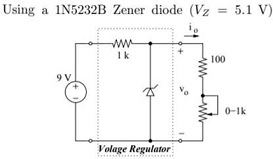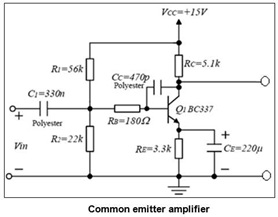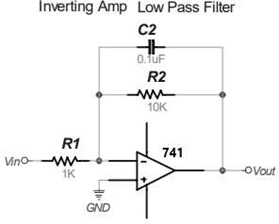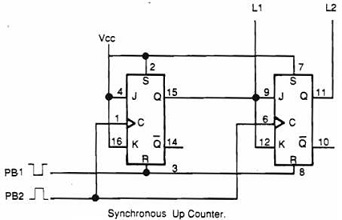Reference no: EM132955318
Unit 52 Further Electrical, Electronic and Digital Principles - Higher National Diploma in ENGINEERING
Assignment - Mathematical techniques and circuit theorems for electrical systems
Learning Outcome 1: Use appropriate laboratory and computer simulation techniques to investigate both analogue and digital circuits and interpret the results.
Learning Outcome 2: Explain the characteristics of non-linear circuits to predict their behavior under a variety of conditions.
PART 1 - ZENER DIODE LAB EXERCISE

a) PRE-LAB:
Describe the characteristics of a zener diode with respect to its terminals, biasing, currents and voltages. Compare the behaviour of a zener diode with an ideal device, such as a resistor, capacitor or inductor.
b) LAB EXERCISE:
(i) Using a "constant voltage" model for the zener region, calculate the output voltage of the regulator (Vo) as a function of its output current (Io).
(ii) Simulate the circuit with RL using the potentiometer as a parameter with a range of 500? to 1k?. Measure the load current and the load voltage. Then, vary the potentiometer resistance and measure the load voltage for a range of load currents. Plot Vo versus Io. Evaluate the application of actual testing with these simulated results by comparing them with the theoretical/expected results. Give at least one (1) reason for any difference with each comparison and justify all comments made, via proper referencing and research.
PART 2 - BIPOLAR TRANSISTOR LAB EXERCISE

a) PRE-LAB:
Describe the characteristics of a bipolar transistor with respect to its terminals, biasing, currents and voltages.
b) LAB EXERCISE:
Simulate the common emitter amplifier circuit, by applying a very low amplitude sine wave (1V peak to peak) to the input. Vary the frequency between 100Hz and 1MHz to obtain six (6) set of output voltage readings.
(i) Calculate the low and high cut-off frequencies, and then calculate the voltage gain at two (2) different frequencies.
(ii) Evaluate the application of actual testing with these simulated cut-off frequencies by comparing them with the theoretical/expected results. Give at least one (1) reason for any difference and justify all comments made, via proper referencing and research.
PART 3 - ANALOGUE CIRCUIT LAB EXERCISE

a) PRE-LAB - Show step by step calculations for the:
(i) Gain of the inverting amplifier circuit above. State any assumptions used.
(ii) Circuit to yield a gain of 30. State any assumptions used.
b) LAB EXERCISE:
(i) Simulate the circuit above, then measure the output voltage by making the input voltage between 2V to 10V volt peak to peak and using frequencies from 10Hz to 3kHz (at least five frequencies should be used). Set the DC + voltage at half of the input ac value. Record all frequencies and corresponding gains.
(ii) Using an appropriate laboratory technique, explain the performance of this analogue circuit. Clearly state the technique considered.
c) PRESENTATION:
Present a clear evaluation of this analogue circuit by providing a graph of gain (dB) vs frequency (Hz) then state the cut-off frequency and bandwidth from the results obtained via simulation. Include:
(i) Comments on any similarities and differences expected between these cut-off frequencies and that expected if actual testing was done.
(ii) A comparison of the max gain obtained via the calculation in the pre-lab and the simulation.
PART 4 - DIGITAL CIRCUIT LAB EXERCISE

a) PRE-LAB:
(i) Fully describe both counter circuits in the synchronous up counter above.
(ii) Re-design the circuit above by making one (1) modification that will allow the circuit above to have a different function. Clearly show all steps and state any assumptions in this new design. State what the new function of the circuit is.
b) LAB EXERCISE:
(i) Simulate the circuit above using 74LS76, then turn on power to the LD-2 and push PB1. Use PB2 as the count input and L1 and L2 as the count outputs. Record your observations of the operation of this circuit. Remove power from the LD-2. Remove the wires from pin 15 of the 74LS76 and wire them to pin 14. Remove the wire from pin 11 of the 74LS76 and place the wire to pin 10. Turn on power to the LD-2. Push PB1, L1 and L2 should light. Record your observations of the circuit operation.
(iii) Using an appropriate laboratory technique, explain the performance of this digital circuit. Clearly state the technique considered.
c) PRESENTATION:
Present a clear evaluation of this digital circuit by showing the comparison and comment on any differences or trends in the operations obtained via simulation and what was expected if actual testing was done.
Attachment:- Electronic and Digital Principles.rar